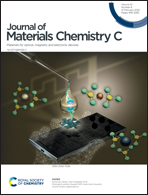Ferroelectric properties in metal-coordinated complex tris(2-hydroxyethyl) ammonium trichloro cadmium(ii)†
Abstract
The metal-coordinated complex tris(2-hydroxyethyl)ammonium trichloro cadmium(II) (TATC) with a space group of P21/c at room temperature was obtained in aqueous solution. A paraelectric–ferroelectric phase transition (from the monoclinic P21/c phase to the monoclinic P21 phase) occurs at a temperature of 270 K/247 K in the heating/cooling process, which belongs to the order–disorder type transition, and is consistent with the thermodynamic analysis from DSC results. The λ-shape dielectric anomaly follows the Curie–Weiss law with a 105.8-fold change at a frequency of 500 Hz. The maximum value of the pyroelectric coefficient Pe is about 0.11 μC cm−2 K−1, which is higher than the classical ferroelectric crystal TGS (5.5 × 10−2 μC cm−2 K−1). The maximum value of the related figures of merit (FOMs) M1 and M2 at a frequency of 1 MHz is 0.0108 cm2 μC−1 and 0.0245 cm3/2 J−1/2, respectively, which is higher than that of TGS (4 × 10−3 cm2 μC−1 and 0.01 cm3/2 J−1/2). The compensation method (the Sawyer–Tower method) and the double-wave method were used to obtain ferroelectric hysteresis loops and display the ferroelectricity of TATC. The spontaneous polarization and the coercive field of TATC can reach about 1.4 μC cm−2 and 0.3 kV cm−1, respectively. The intense dielectric anomaly and the near-room-temperature Tc value indicate that TATC can be an applicable dielectric switching material.



 Please wait while we load your content...
Please wait while we load your content...